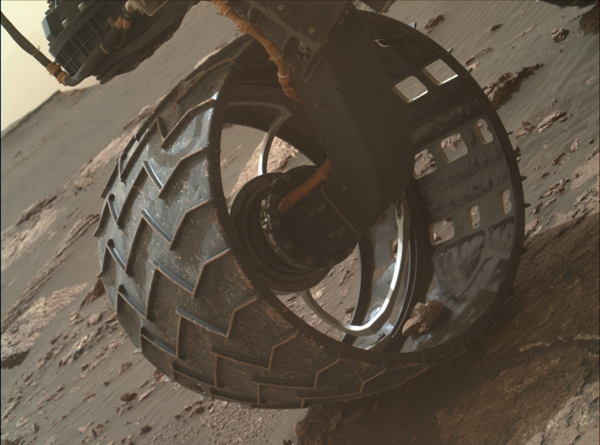A few weeks ago, a large rock got caught in one of the wheels of the Mars Curiosity rover. It’s an occupational hazard: unlike a car on Earth, the rover’s aluminum wheels are open on the sides with large cleats. That design allows Curiosity to go over rough terrain, including jagged rocks that would destroy other kinds of wheels.
Looking at pictures of the rock inside the wheel, Mars spacecraft engineer Kristin Block of University of Arizona’s Lunar and Planetary Laboratory idly asked: how loud would the rock sound?
I wonder how loud a racket that’s making during drives.
It’s a simple question, but one with a lot of pieces. To answer it, we need to look at the design of the Curiosity rover, the nature of sound on Mars, and the way humans perceive loudness. And of course how science fiction movies lead us astray.
Curiosity is a robotic (uncrewed) car-sized vehicle with six wheels. Each of those wheels is 20 inches (50 centimeters) and 16 inches (40 centimeters) wide, with holes in the wheel designed to make it easy to show how far the rover has traveled when looking back over its tracks (which you can see in the image below). To monitor its health, Curiosity has a camera designed to check those wheels, along with anything else on the robot’s exterior. That’s how we know about the rock. From the pictures, it looks like the rock is about 2 inches (5 centimeters) across, big enough to be noticeable and much bigger than the holes in the wheels.
However, Curiosity’s top speed is centimeters per second, or about 0.09 miles per hour. At that sloth-like speed, Mars’ extremely rough terrain is less likely to damage the rover. It also means a rock inside Curiosity’s wheel won’t be like throwing a brick into a clothes dryer. Instead, the rock seemed to slide up and down as the rover moved, and eventually fell out again. In fact, this isn’t even the first rock to get into the wheels.
On Earth, this would produce a quiet scraping noise of rock on metal. Mars’ atmosphere is much thinner and drier than Earth’s, and is made primarily of carbon dioxide, as opposed to Earth’s mixture of nitrogen, oxygen, and water vapor. The chemistry and density of air dictates the speed of sound, the pitch of sound (how high or low a tone sounds), and how loud a noise is.
Obviously a human isn’t going to be walking around Mars without a pressurized helmet: the thin, poisonous atmosphere would kill us pretty quickly. But let’s pretend for a moment that we could survive long enough to listen for the sound of the rock in Curiosity’s wheel.
The air pressure on Mars is less than one percent of the air pressure at sea level on Earth. Since sound is a pressure wave — molecules bunching up and spreading out in wave patterns — the thin atmosphere would make every sound much quieter on Mars than Earth. In addition, the atmospheric chemistry makes the speed of sound lower on Mars, which in turn makes the sound pitch lower, though not by a huge margin. (The Planetary Society website has clips where you can hear Bill Nye, Ray Bradbury, and others as though they were talking on Mars.) Movies like The Martian make the Red Planet sound a lot like Earth for dramatic purposes, but it’s much quieter in reality.
To put it all together: the rock in Curiosity’s wheel would sound like a quiet, somewhat low-pitched scraping sound. In other words, nothing too dramatic. Curiosity itself is driven by six electric motors, one for each wheel, and while those aren’t very loud, they might be louder than the rock sliding around.
However, we don’t have direct evidence for this because Curiosity doesn’t carry a microphone. It has lots of other scientific equipment, from cameras to chemistry labs, but nothing to pick up sound. In fact, the only mission to carry a microphone so far was the Mars Polar Lander, which failed and crashed. The upcoming Mars 2020 mission will carry a microphone, though, for the purpose of finding out what kinds of sounds Mars has. Those include the ones we expect — wind, dust storms, lightning — but scientists care particularly about the ones we don’t anticipate. Not just rocks in the wheels.
Source: http://bit.ly/2oFj5rO











